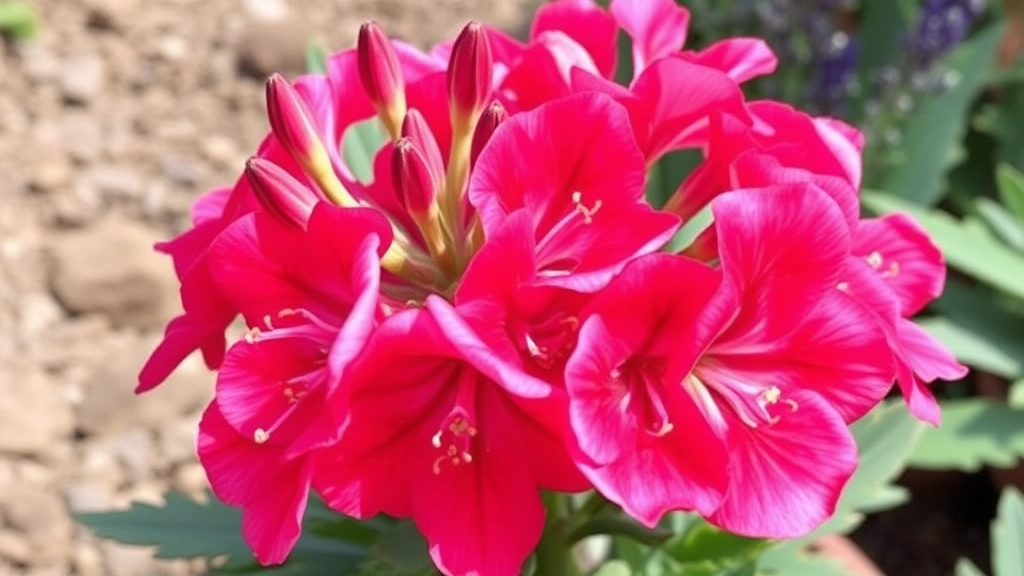Mastering the Care for Your Flaming Katy Kalanchoe Blossfeldiana
Looking to master the art of caring for your Flaming Katy Kalanchoe Blossfeldiana? You’re in the right place. This vibrant succulent, known for its stunning flowers, is a favourite among plant enthusiasts for good reason. From watering needs to lighting requirements, I’ll guide you through everything you need to know to keep your Flaming Katy thriving.
Propagation of Kalanchoe Blossfeldiana
Wondering how to propagate your Kalanchoe Blossfeldiana? It’s simpler than you might think. Whether you’re using stem cuttings or offsets, I’ll break down the steps to ensure successful growth. Plus, I’ll share tips on soil choice, fertilizing schedules, and even how to keep common pests at bay. Let’s dive into making your Flaming Katy the healthiest and most beautiful plant in your collection.
Are you struggling to keep your Flaming Katy, or Kalanchoe Blossfeldiana, thriving? You’re not alone. Many plant enthusiasts face challenges in providing the right care for this vibrant succulent.
Flaming Katy is known for its stunning blooms and ease of care, but a few essential tips can make all the difference in ensuring your plant flourishes. Here’s what you need to know:
Watering Needs for Kalanchoe Blossfeldiana
– **Frequency**: Water your Flaming Katy every 2-3 weeks, allowing the soil to dry out completely between waterings.
– **Signs of Overwatering**: Yellowing leaves and mushy stems indicate too much water.
– **Signs of Underwatering**: Droopy leaves and a shrivelled appearance suggest your plant needs hydration.
Understanding these watering needs is crucial for your Flaming Katy’s health.
Lighting Requirements: Indoor vs Outdoor
– **Indoor**: Place your plant in a bright, sunny spot, ideally near a south-facing window.
– **Outdoor**: If keeping it outside, ensure it receives partial sunlight, especially during the hottest part of the day.
With the right light, your Flaming Katy will thrive and produce beautiful blooms.
Propagation Methods: Stem Cuttings and Offsets
– **Stem Cuttings**: Take a healthy stem, let it callous for a few days, and then plant it in well-draining soil.
– **Offsets**: Look for small plants at the base of the parent plant; gently remove and plant them separately.
These propagation methods not only help you expand your collection but also ensure your plants remain healthy and vibrant.
Soil and Potting Mix for Optimal Growth
– **Soil Type**: Use a well-draining cactus or succulent mix.
– **Potting**: Ensure your pot has drainage holes to prevent waterlogging.
Choosing the right soil is fundamental for your Flaming Katy’s success.
Fertilizing Schedule for Prolonged Flowering
– **Frequency**: Fertilize every 4-6 weeks during the growing season with a balanced, water-soluble fertilizer.
– **Dilution**: Always dilute the fertilizer to half strength to avoid burning the roots.
A proper fertilizing schedule encourages lush growth and abundant blooms.
Common Pests and Diseases of Flaming Katy
– **Pests**: Watch out for mealybugs and aphids. Treat infestations with insecticidal soap or neem oil.
– **Diseases**: Root rot can be a problem; ensure proper watering practices to prevent it.
Being aware of potential pests and diseases helps you take proactive measures.
Pruning and Deadheading for Healthy Growth
– **Pruning**: Trim back leggy growth to encourage bushier growth.
– **Deadheading**: Remove spent flowers to promote new blooms.
Regular pruning keeps your Flaming Katy looking its best and encourages more vibrant flowers.
Repotting Guidelines for Kalanchoe Blossfeldiana
– **When to Repot**: Repot every 1-2 years or when the plant outgrows its pot.
– **Method**: Gently remove the plant from its pot, shake off excess soil, and place it in a new pot with fresh soil.
Repotting is essential for maintaining a healthy root system and overall plant vitality.
How to Encourage Reblooming in Flaming Katy
– **Light**: Ensure your plant receives adequate light.
– **Watering**: Follow the recommended watering schedule.
– **Temperature**: Keep your plant in a stable environment, avoiding extreme temperature fluctuations.
Encouraging reblooming can keep your Flaming Katy in a constant state of beauty.
Flaming Katy in Indoor Décor and Landscaping
Flaming Katy is not just a lovely plant; it adds a pop of colour to any indoor space or garden.
Р**Indoor D̩cor**: Use it as a centrepiece on a coffee table or in a bright kitchen.
– **Landscaping**: Plant it in sunny garden beds or alongside other succulents for a stunning display.
For more detailed information on how to care for Kalanchoe Blossfeldiana, check out our [Flaming Katy Care Guide](https://planthq.org/flaming-katy-kalanchoe-blossfeldiana-care-guide/). Additionally, if you’re interested in expanding your collection, you might find our guide on [How to Propagate Kalanchoe](https://planthq.org/how-to-propagate-kalanchoe-copper-spoons-cuttings/) useful.
Watering Needs for Kalanchoe Blossfeldiana
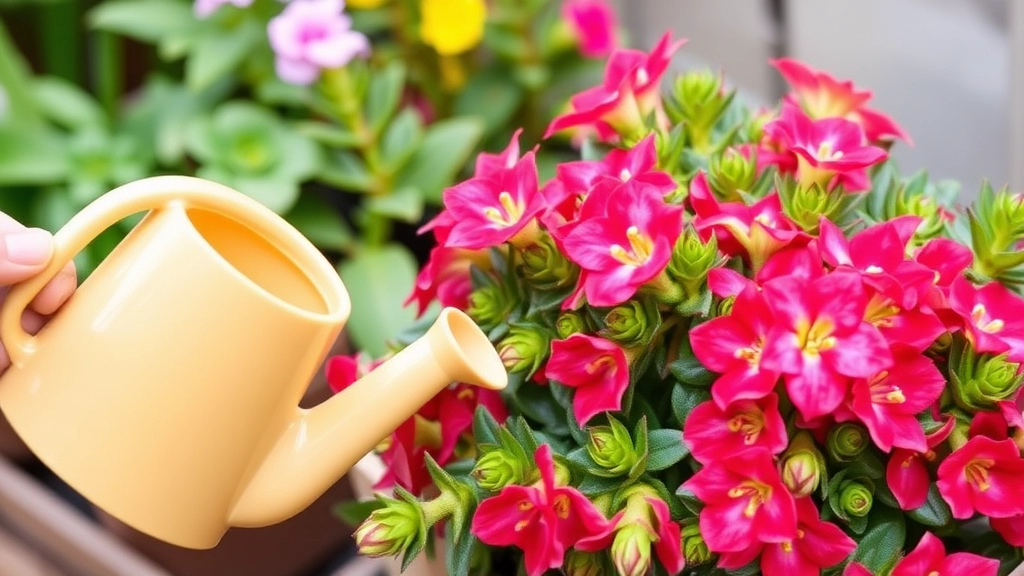
Are you wondering how to keep your Flaming Katy thriving without drowning it?
Watering is one of the trickiest bits of plant care, but it doesn’t have to be.
Here’s the lowdown on watering Kalanchoe Blossfeldiana:
- Check the Soil: Always feel the top inch of the soil. If it’s dry, it’s time to water. If it’s still damp, wait a bit longer.
- Watering Frequency: During the growing season (spring and summer), you might water every 1-2 weeks. In the winter, cut back to once every 3-4 weeks.
- Drainage is Key: Make sure your pot has drainage holes. Kalanchoes hate sitting in water, and too much can lead to root rot.
- Water Thoroughly: When you do water, soak the soil until water drains out of the bottom. This encourages deep root growth.
- Use Room Temperature Water: Cold water can shock the plant. Aim for room temperature to keep your Flaming Katy happy.
- Humidity Matters: Kalanchoes prefer drier air. If you live in a humid area, you might need to adjust your watering schedule.
Remember, it’s better to underwater than overwater. Your Flaming Katy will forgive you for a missed drink but not for soggy roots!
Lighting Requirements: Indoor vs Outdoor
When caring for your Flaming Katy, understanding its lighting needs is crucial for its health and blooming potential. Many plant enthusiasts wonder whether their Kalanchoe Blossfeldiana will thrive indoors or outdoors.
Propagation Methods: Stem Cuttings and Offsets
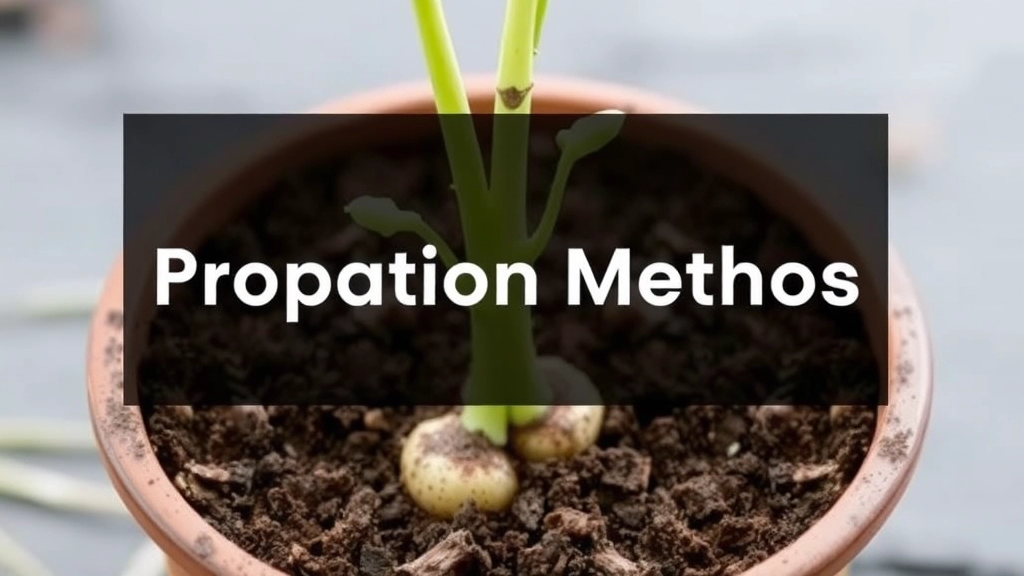
When it comes to expanding your Flaming Katy collection, understanding propagation methods is essential. Many enthusiasts often wonder how to successfully propagate Kalanchoe Blossfeldiana, and the good news is that it can be done easily through stem cuttings and offsets.
Stem Cuttings
Propagating Flaming Katy via stem cuttings is straightforward and rewarding. Here’s how to do it:
- Choose Healthy Stems: Look for healthy, plump stems that are free from pests or disease. Ideally, select stems that have recently bloomed.
- Make the Cut: Using clean, sharp scissors, cut a stem about 10 to 15 cm long. Ensure you make the cut just below a leaf node.
- Let It Callous: Place the cut stem in a dry area for a few hours or overnight. This allows the cut end to callous over, reducing the risk of rot when planted.
- Plant in Soil: Fill a small pot with a well-draining potting mix. Insert the calloused end of the stem into the soil, ensuring it is stable.
- Water Sparingly: After planting, water lightly. Avoid overwatering, as this can lead to rot.
- Provide Proper Conditions: Place the pot in a bright, indirect light location and maintain a warm temperature.
Offsets
Offsets are another effective way to propagate Flaming Katy. These are small plants that grow around the base of the parent plant.
- Identify Offsets: Look for small rosettes at the base of your Kalanchoe.
- Remove Carefully: Gently twist or cut the offset away from the parent plant, making sure to include some roots.
- Plant in Soil: Similar to stem cuttings, plant the offsets in a well-draining potting mix.
- Water and Care: Follow the same watering and light conditions as you would for stem cuttings.
Soil and Potting Mix for Optimal Growth
When it comes to ensuring your Flaming Katy thrives, the right soil and potting mix play a crucial role. Many plant enthusiasts often wonder what type of soil is best for Kalanchoe Blossfeldiana.
Key Considerations for Soil:
- Well-Draining Mix: Flaming Katy prefers a potting mix that allows excess water to drain away.
- Cactus or Succulent Soil: A pre-made cactus or succulent mix is ideal due to its coarse texture and excellent drainage properties.
- pH Level: Aim for a slightly acidic to neutral pH (around 6.0 to 7.0) for optimal growth.
DIY Potting Mix Recipe:
If you prefer a homemade approach, consider this simple recipe:
- 2 parts potting soil
- 1 part perlite or coarse sand
- 1 part peat moss or coconut coir
This combination ensures that your Flaming Katy receives the nutrients it needs while preventing root rot.
Potting Tips:
- Choose the Right Pot: Ensure your pot has drainage holes to facilitate water escape.
- Repotting Frequency: Repot every 1-2 years or when the plant outgrows its container. For more detailed guidance, you can refer to the complete care guide for Kalanchoe Blossfeldiana.
Additionally, if you’re interested in expanding your collection, consider learning about the step-by-step guide to growing Kalanchoe from leaf cuttings.
Fertilizing Schedule for Prolonged Flowering
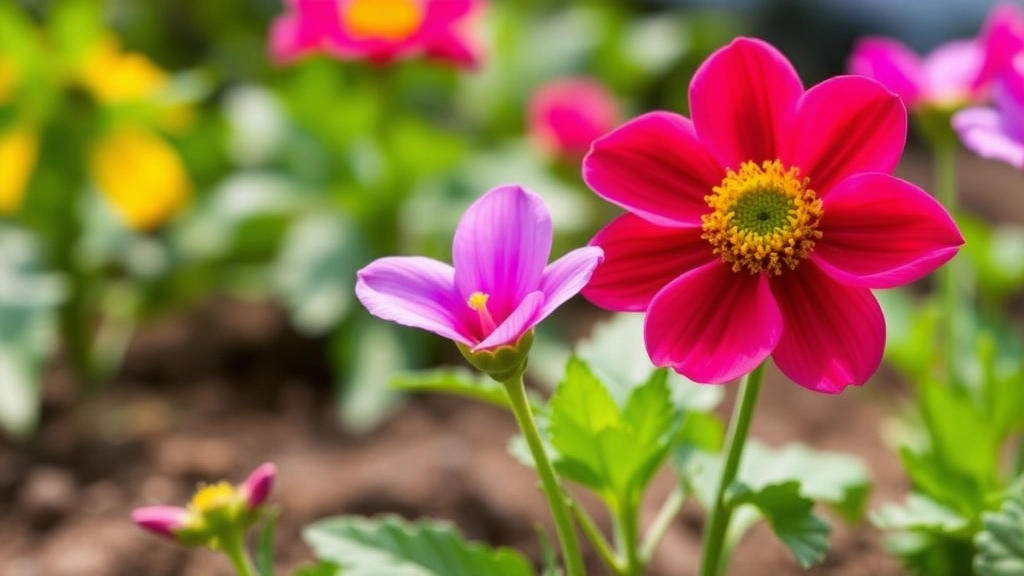
So, you’ve got your Flaming Katy blooming beautifully, but how do you keep those vibrant flowers coming back for more?
Fertilizing is key to ensuring your Kalanchoe Blossfeldiana stays healthy and keeps producing those stunning blooms.
When to Fertilize:
- Growing Season: Aim to fertilize during the spring and summer months when the plant is actively growing.
- Frequency: Every 4-6 weeks is a good rule of thumb. You want to give it just enough boost without overdoing it.
What to Use:
- Balanced Fertilizer: A balanced, water-soluble fertilizer (like a 20-20-20) works wonders.
- Dilution: Always dilute it to half strength. Too much can burn those lovely leaves.
Signs Your Plant Needs More:
- If the leaves start to look pale or the blooms are fewer, it might be time to up your fertilizing game.
Extra Tips:
- Water First: Always water your plant before applying fertilizer. This helps prevent root burn.
- Stop Fertilizing in Fall: As the plant enters dormancy, cut back on feeding. It’s like giving it a well-deserved break.
As we delve deeper into the care of Flaming Katy, it’s essential to address the common pests and diseases that can affect Kalanchoe Blossfeldiana. Understanding these issues will help you maintain a healthy and vibrant plant.
### Pests to Watch For
Flaming Katy can attract a few pesky intruders. Here are the most common pests you might encounter:
– **Aphids**: Tiny, sap-sucking insects that can cause leaves to curl and distort.
– **Mealybugs**: White, cotton-like pests that cling to stems and leaves, leading to yellowing and wilting.
– **Spider Mites**: These tiny arachnids thrive in dry conditions and can create fine webs on the plant.
– **Scale Insects**: Hard, shell-like pests that attach themselves to the plant, robbing it of nutrients.
### Diseases to Be Aware Of
In addition to pests, Flaming Katy can suffer from certain diseases. Here are a few to keep an eye on:
– **Root Rot**: Caused by overwatering, leading to mushy roots and plant decline.
– **Leaf Spot**: Fungal infections that create dark spots on leaves, often due to high humidity.
– **Powdery Mildew**: A white, powdery substance that appears on leaves, typically from poor air circulation.
### Prevention and Treatment
To keep your Flaming Katy thriving, consider these tips:
– **Regular Inspections**: Check your plant weekly for any signs of pests or diseases.
– **Proper Watering**: Avoid overwatering to prevent root rot; let the soil dry out between waterings.
– **Good Air Circulation**: Ensure your plant has enough airflow to prevent fungal issues.
– **Neem Oil or Insecticidal Soap**: Use these treatments for pest infestations; they are effective and eco-friendly.
By staying vigilant and taking proactive measures, you can keep your Flaming Katy healthy and blooming beautifully. For more detailed care instructions, you might find our [comprehensive Kalanchoe species list for gardeners](https://planthq.org/comprehensive-kalanchoe-species-list-for-gardeners/) useful. Additionally, if you’re dealing with specific issues like leaf curling, check out our guide on [causes and solutions for Kalanchoe leaves curling](https://planthq.org/causes-and-solutions-for-kalanchoe-leaves-curling/).
Pruning and Deadheading for Healthy Growth
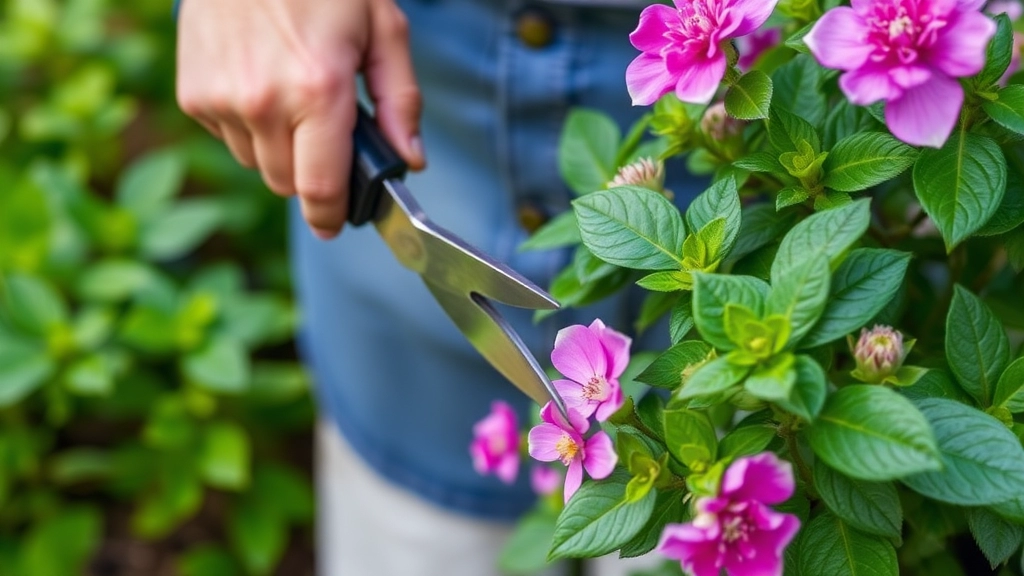
So, you’ve got your Flaming Katy (Kalanchoe Blossfeldiana) looking lovely, but how do you keep it blooming and thriving?
Pruning and deadheading are key to maintaining its health and encouraging new growth.
Why Prune?
- Promotes New Growth: Cutting back old stems encourages fresh shoots.
- Enhances Airflow: Removing crowded branches helps prevent pests and diseases.
- Keeps It Neat: A tidy plant looks better and fits nicely in your indoor décor.
When to Prune:
- After the blooming season, usually in late spring.
- If you notice any dead or wilted leaves throughout the year.
How to Prune:
- Use clean, sharp scissors or shears.
- Cut just above a leaf node to encourage new growth.
- Aim to remove about one-third of the plant if it’s looking too bushy.
Deadheading Made Easy:
- What’s deadheading? It’s simply removing spent flowers to promote more blooms.
- Gently pinch or cut off the faded flowers at their base.
- This helps the plant focus its energy on producing new flowers instead of seed production.
Quick Tips for Success:
- Always prune in the morning when the plant is hydrated.
- Clean your tools before and after to avoid spreading diseases.
- Don’t be afraid to be a bit ruthless; a well-pruned plant will reward you with vibrant blooms.
Repotting Guidelines for Kalanchoe Blossfeldiana
Repotting is a crucial aspect of maintaining a healthy Flaming Katy. You might be wondering when and how to repot your Kalanchoe Blossfeldiana to ensure it thrives.
How to Encourage Reblooming in Flaming Katy
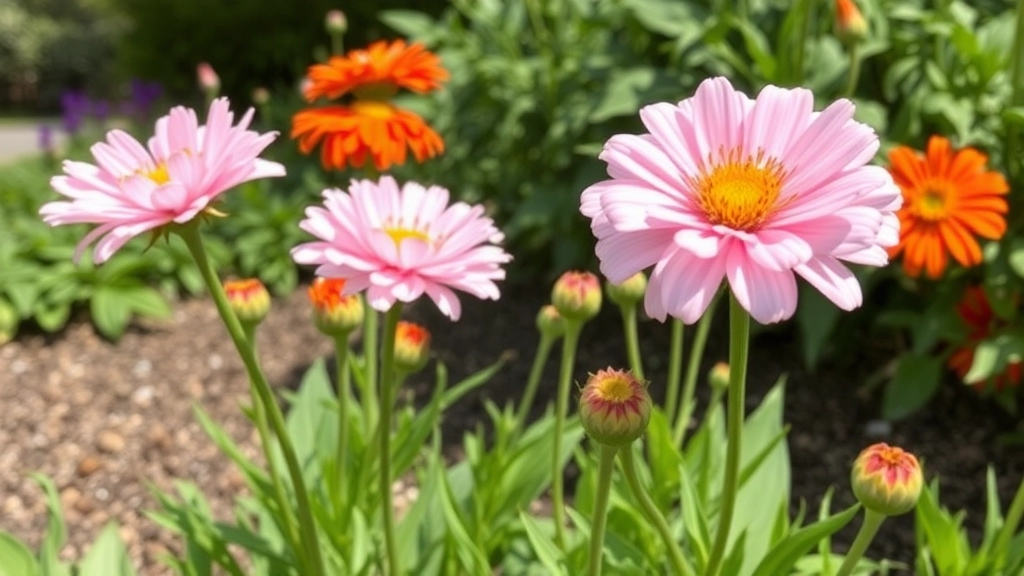
So, you’ve got your Flaming Katy (Kalanchoe Blossfeldiana) blooming beautifully, but now you’re wondering how to get it to flower again.
No worries, I’ve been there too!
Here are some simple tips to encourage reblooming in your Flaming Katy:
- Light Exposure: Make sure your plant gets plenty of bright, indirect sunlight. A south-facing window is a winner. If it’s not getting enough light, it might just sulk instead of blooming.
- Watering Routine: Let the soil dry out between waterings. Overwatering can lead to root rot, which is a total buzzkill for blooms.
- Temperature Control: Keep your Flaming Katy in a warm spot, ideally around 20-25°C. They love warmth but don’t like drafts.
- Pruning: After the first round of flowers fades, give it a little trim. Snip off spent blooms and any leggy growth. This encourages fresh growth and new flowers.
- Fertilizing: Use a balanced fertilizer every couple of weeks during the growing season. This gives your plant the nutrients it needs to produce those lovely flowers.
- Rest Period: After blooming, let your plant have a rest period. Reduce watering and stop fertilizing for about six weeks. This helps it recharge and get ready for the next bloom.
- Patience is Key: Sometimes, all it takes is a bit of time. Keep caring for your plant, and soon enough, you’ll see those gorgeous flowers popping up again!
Flaming Katy in Indoor Décor and Landscaping
Are you looking to enhance your indoor space or garden with vibrant colour and charm?
Flaming Katy, or Kalanchoe Blossfeldiana, is an excellent choice for both indoor décor and landscaping.
Indoor Décor
Incorporating Flaming Katy into your home can elevate your interior design.
Here are some ideas to get you started:
- Brighten Up Your Living Room: Place a pot of Flaming Katy on a coffee table or shelf for a pop of colour.
- Window Sills: These plants thrive in bright light, making them perfect for sunny window sills.
- Desk Companion: A small pot on your work desk can boost your mood and productivity.
- Group Arrangements: Combine Flaming Katy with other succulents for a stunning display.
Landscaping
If you’re considering outdoor options, Flaming Katy can transform your garden or patio.
- Flower Beds: Use them as border plants to add a splash of colour.
- Container Gardens: They thrive in pots, making them ideal for patios and balconies.
- Rock Gardens: Their succulent nature allows them to flourish in rocky or sandy soil.
Care Considerations
When using Flaming Katy in your décor or landscaping, remember:
- Watering Needs: Ensure proper drainage to prevent root rot. For more tips, check out our Optimal Watering Tips for Healthy Florist Kalanchoe.
- Lighting: Position them where they can receive ample sunlight.
- Seasonal Care: Be mindful of temperature changes, especially during winter. Learn more in our guide on Caring for Kalanchoe After Flowering.
Flaming Katy not only adds beauty but also brings a sense of life to any space.
FAQs on Flaming Katy (Kalanchoe Blossfeldiana)
How often should I water my Flaming Katy?
During the growing season (spring and summer), water every 1-2 weeks. In winter, reduce watering to once every 3-4 weeks. Always check the top inch of soil; if it’s dry, it’s time to water.
What type of soil is best for Kalanchoe Blossfeldiana?
Use a well-draining potting mix. Ensure your pot has drainage holes to prevent water from sitting at the bottom, which can lead to root rot.
How do I propagate my Flaming Katy?
Propagation can be done through stem cuttings or offsets. For stem cuttings, choose healthy stems, let them callous, then plant them in soil. For offsets, gently remove small rosettes that grow at the base and plant them similarly.
When and how should I fertilize my Kalanchoe Blossfeldiana?
Fertilize during the spring and summer months every 4-6 weeks using a balanced, water-soluble fertilizer diluted to half strength. Always water your plant before applying fertilizer to prevent root burn.
Why is pruning important for my Flaming Katy?
Pruning promotes new growth, enhances airflow, and keeps the plant looking neat. It’s best done after the blooming season or when you notice dead or wilted leaves.
How do I encourage my Flaming Katy to rebloom?
Ensure it gets plenty of bright, indirect sunlight, let the soil dry out between waterings, keep it in a warm spot, and prune after the first round of flowers fades. Fertilize every couple of weeks during the growing season and give it a rest period after blooming.
What are the signs that my plant needs more fertilizer?
If the leaves start to look pale or the blooms are fewer, it might be time to increase your fertilizing frequency.
Can I use cold water to water my Flaming Katy?
No, it’s best to use room temperature water. Cold water can shock the plant and potentially harm it.
What should I do if my Kalanchoe Blossfeldiana is not blooming?
Ensure it receives enough light, water it properly, maintain a warm temperature, prune spent blooms, fertilize regularly during the growing season, and allow it a rest period after blooming.
How can I prevent root rot in my Flaming Katy?
Make sure your pot has drainage holes and avoid overwatering. It’s better to underwater than overwater, as Kalanchoes can tolerate drought better than soggy roots.
References
-
Gardening Know How – Kalanchoe Care
-
The Spruce – How to Grow Kalanchoe Indoors
-
Gardener’s World – How to Grow Kalanchoe
